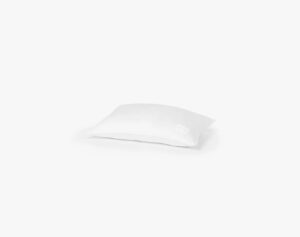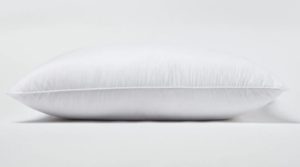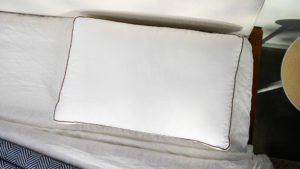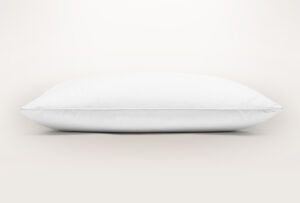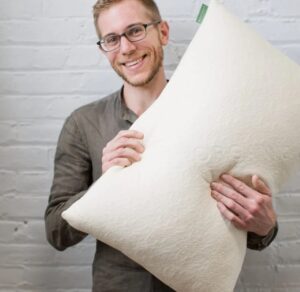Price:
$55 – $70When you buy through our links, we may earn a commission. Products or services may be offered by an affiliated entity. Learn more.
The best hypoallergenic pillows are typically made from materials like foam, latex, or down alternative fibers that are less likely to harbor potential allergens. Other important considerations when choosing a pillow are personal support and cushioning needs, temperature preferences, and priorities for natural or sustainable materials.
Paying attention to bedding materials is essential for any shopper, but it’s especially important if you have allergies. Pillows made with materials like down can collect dust, dirt, and mildew. These particles can trigger or worsen allergies if they are not removed or cleaned, leading to symptoms like congestion and watery eyes that negatively affect your sleep.
We’ll go over our top picks for hypoallergenic pillows, discussing each pick’s construction and performance across our testing criteria. We’ll also cover each pillow’s shipping information, sleep trials, and warranties so you can decide what the best pillow is for your needs.
Product Details
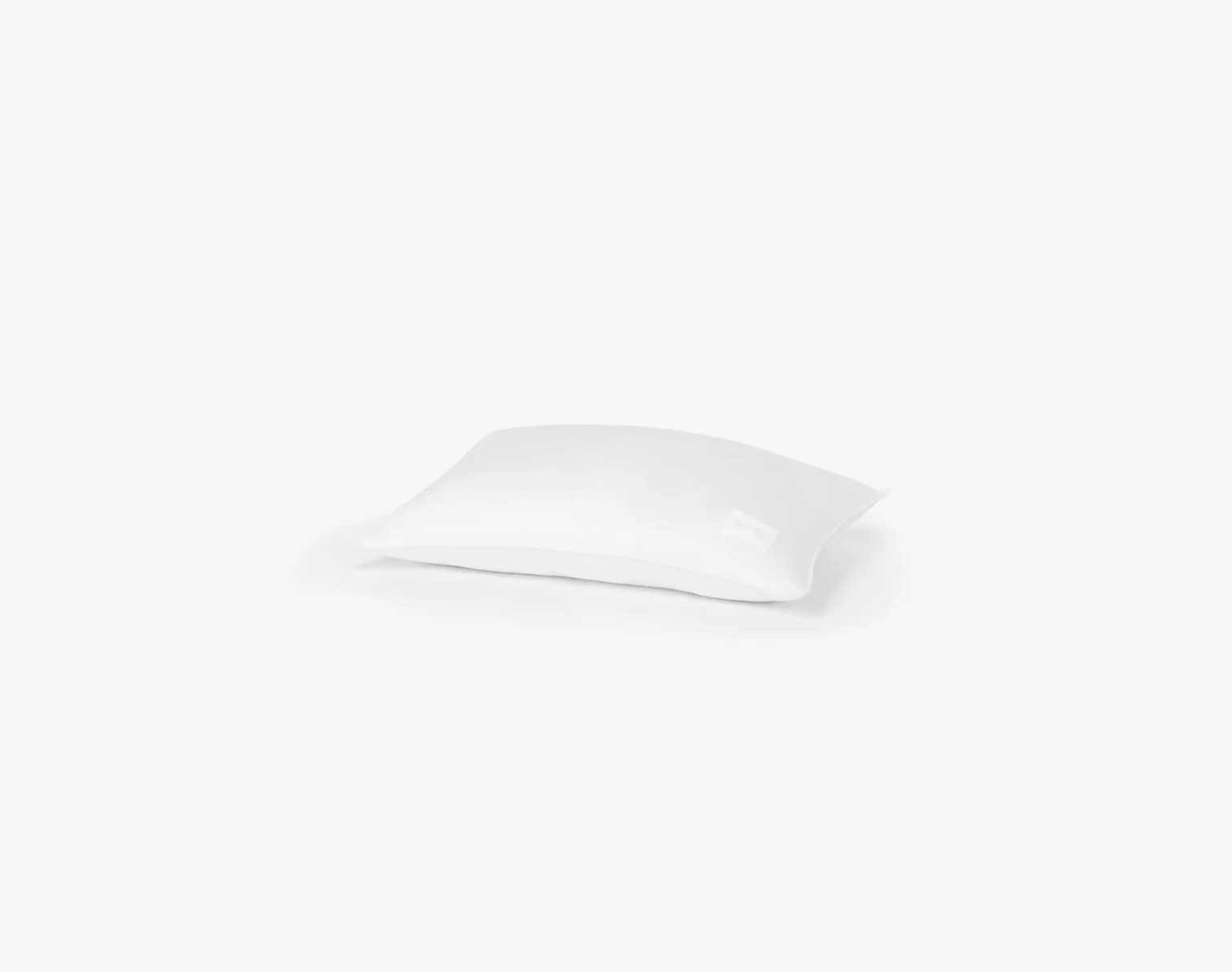
Best Overall
Buffy Cloud Pillow

Fill:
Recycled PET fibersFirmness:
Soft, Medium, Firm-
Who it’s best for
- Sleepers weighing up to 230 pounds
- Eco-conscious shoppers
- Hot sleepers
-
Highlights
- Made from recycled materials
- Breathable Tencel lyocell cover helps regulate temperature
- Three firmness level options
Sleep Foundation Special Offer
Use this link for the most current Buffy discounts
Bottom Line
Many pillows made with sustainable or recycled materials can hold a higher price-point, but the Buffy Cloud Pillow is a notable exception. The pillow boasts hypoallergenic, sustainable materials and premium performance without the high sticker price.
The Buffy Cloud Pillow is made from recycled and sustainably sourced materials, making it an excellent choice for eco-minded shoppers on a budget. You can also choose from three firmness levels, which made it a standout option among our testers.
How It Performed
The Buffy Cloud Pillow is offered in soft, medium, and firm, which appealed to our testers across sleeping positions. The softest model earned its highest ratings from our stomach sleepers under 230 pounds who prefer their heads to sink deeper into the pillow. Our side and back sleepers under 230 pounds found the medium model’s balanced feel the most comfortable. Meanwhile, the firm model offered great support to side sleepers and helped them maintain healthy sleep postures.
Thanks to the fiberfill, the pillow is quite moldable. This makes it great for sleepers who prefer to snuggle a pillow at night or move the fill around for extra support. The fiberfill and breathable cover also help regulate the pillow’s internal and surface temperatures. Hot sleepers on our team reported minimal heat buildup when sleeping with this pillow.
What It’s Made Of
The pillow’s interior features PET fibers made from recycled water bottles. The fibers give the pillow a lofty feel that contours to the neck and offers a down-like feel without triggering allergy symptoms. A breathable Tencel lyocell shell in a silky sateen weave encases the pillow. The material is also naturally moisture-wicking, so people who sweat at night or live in humid climates should feel comfortable and dry throughout the night. The pillow can only be spot cleaned or dry cleaned, so Buffy recommends using a washable pillowcase.
Buffy offers free shipping for customers living in the contiguous U.S. You have seven days to test the pillow before you’re charged. After the trial period, the Cloud Pillow is backed by a 50-night return period.
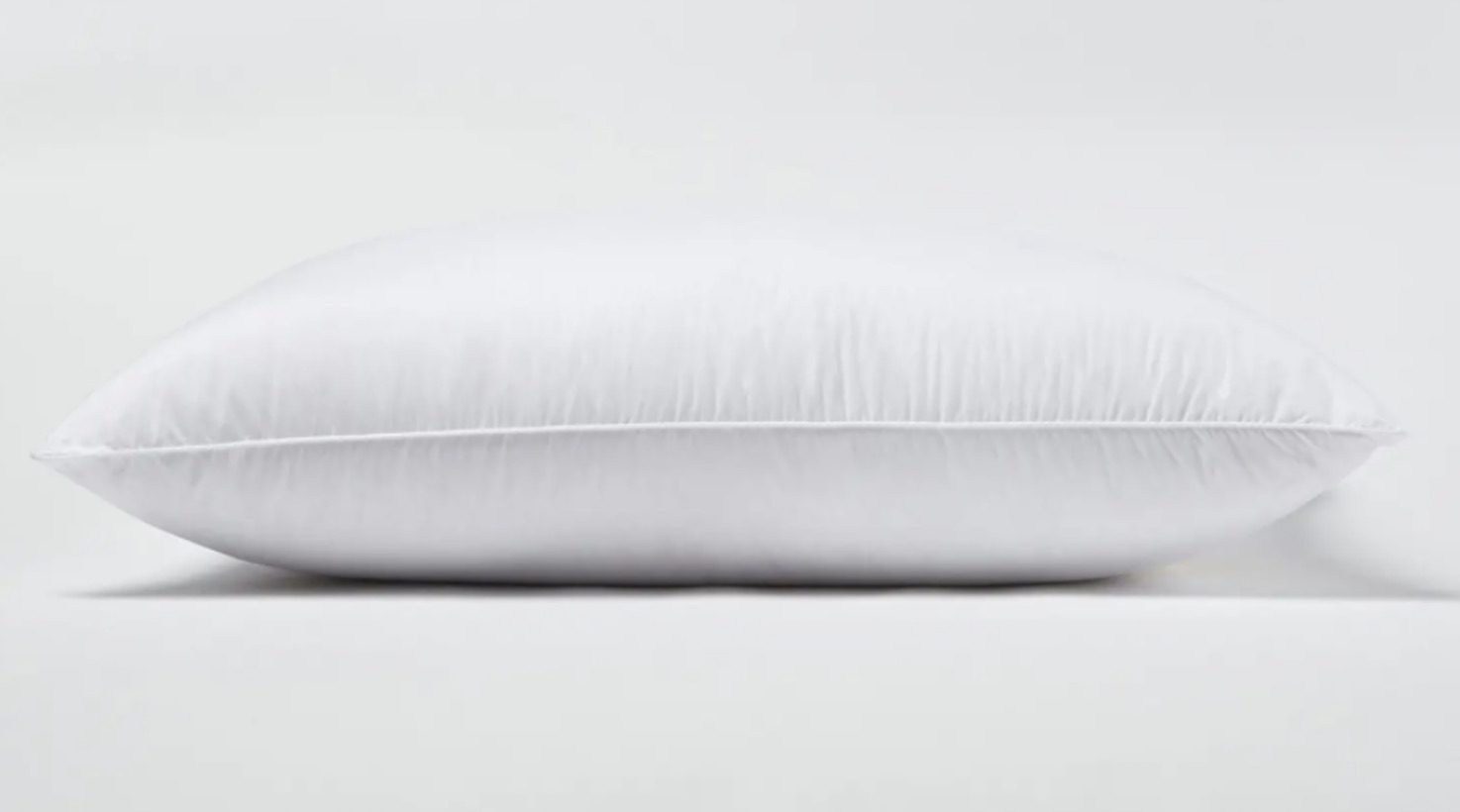
Best Value
Quince Premium Down Alternative Pillow

Price:
$69 – $89Fill:
Down alternative microfibersFirmness:
Medium Soft, Medium Firm-
Who it’s best for
- Hot sleepers
- People seeking an animal-friendly alternative to down pillows
- Sleepers with neck pain
-
Highlights
- Available in two firmness options
- Microfiber fill mimics the luxurious feel of down
- Fully machine-washable
Sleep Foundation Special Offer
Use this link for the most current discount.
Bottom Line
The Quince Premium Down Alternative Pillow comes in two firmness options that appealed to the back and side sleepers on our team, and even some stomach sleepers. The price-point is surprisingly reasonable considering how luxurious and fluffy it felt to our testers.
The Quince Premium Down Alternative Pillow offers excellent contouring for the neck without causing the head to sink too deeply. Our testers singled out the pillow for its affordable price-point, which is much lower than some competing pillows we’ve tried out.
How It Performed
The pillow comes in two firmness options — soft/medium and medium/firm. The soft/medium was popular with our back sleepers, since it deeply cradled the head while maintaining just enough support to ensure elevation. Some stomach sleepers also found this option comfortable. The firmer option appealed to side sleepers, who appreciated the extra support to keep the head, neck, and spine in alignment.
The pillow performed quite well in our temperature regulation tests. Down alternative stays fairly cool, and the breathable cotton cover helps to reduce heat buildup on the surface.
What It’s Made Of
Down alternative microfiber fill makes up the pillow’s core. The fill mimics the cloud-like feel of down but is not sourced from animals. The cotton cover has a sateen weave that produces a silky soft feel. You may machine-wash the pillow in cold water on a gentle cycle, then machine dry on a low heat setting. The pillow is available in standard or king size options.
Quince offers free shipping throughout all 50 states. You’ll also receive a generous 365-night sleep trial.
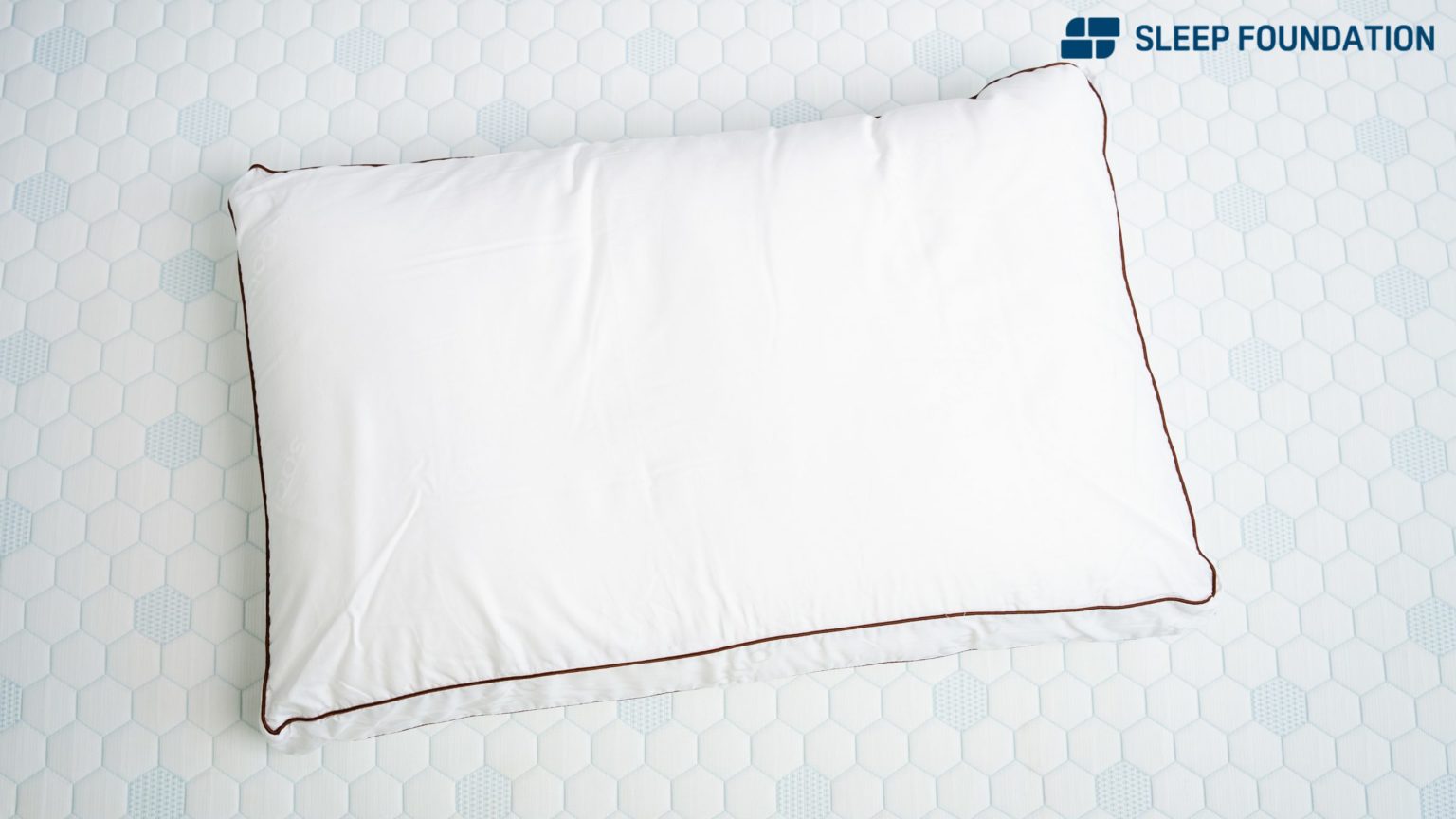
Best Luxury
Saatva Latex Pillow
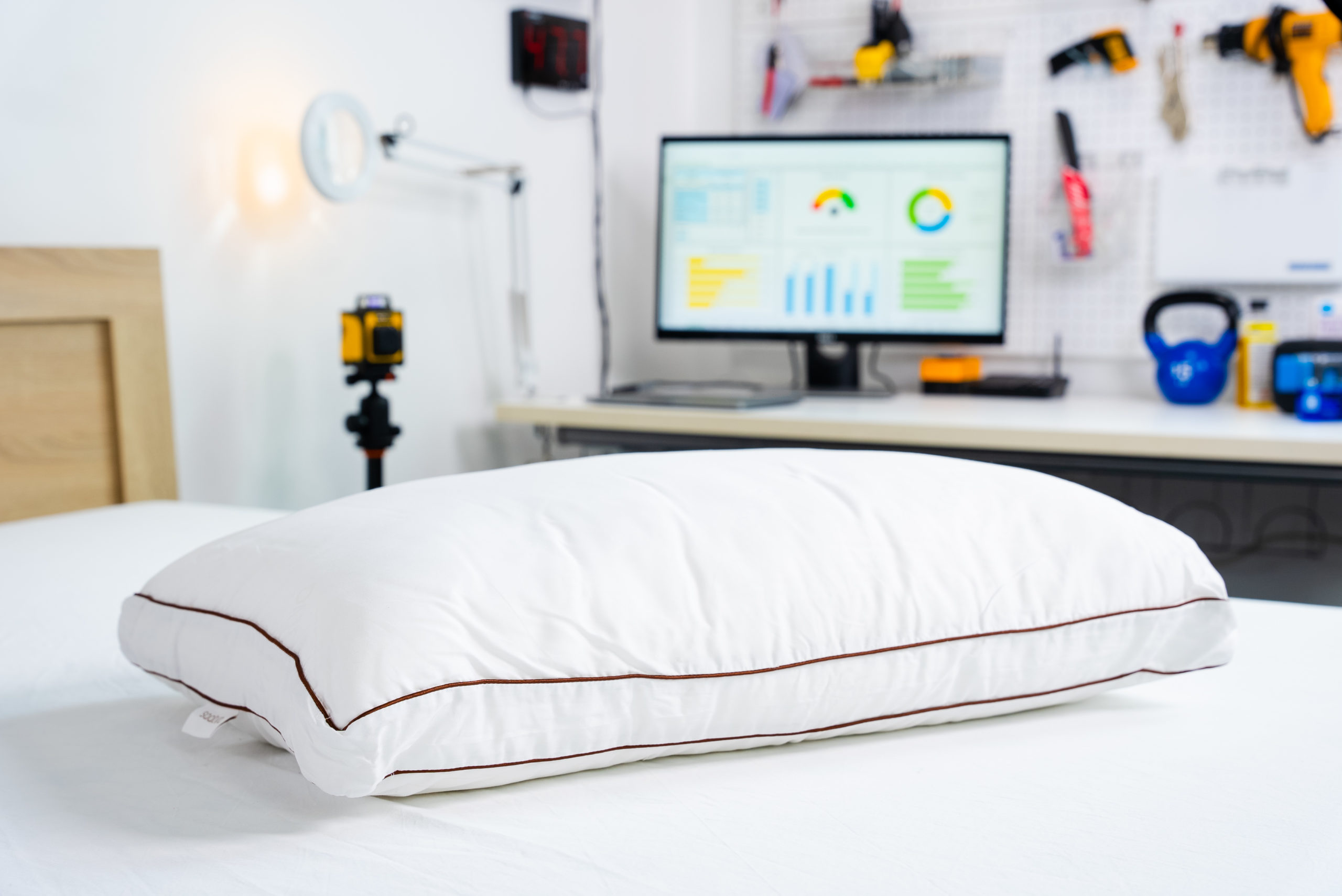
Price:
$165 – $185Fill:
Shredded Talalay latex and down alternativeFirmness:
Medium Soft-
Who it’s best for:
- People willing to spend a bit more on a high-quality latex pillow
- Hot sleepers
- Those who want an adjustable loft
-
Highlights:
- Breathable organic cotton cover helps keep the surface cool
- Shredded Talalay latex and down alternative fibers cradle the head and neck and alleviate pressure
- Loft can be adjusted between 2 and 8 inches thick
Sleep Foundation Special Offer
Use this link for the most current discount.
Bottom Line
A balance of cushioning and responsive support, as well as an adjustable design, made the Saatva Latex Pillow appealing to many of our testers. The pillow is adjustable between 2 and 8 inches thick, so most side and back sleepers should find a height that fits their needs.
The Saatva Latex Pillow is a high-end model for those who prefer latex’s natural cradling and cooling properties. An adjustable design also makes the pillow suitable for many sleeper types since fill can be added or removed to customize the loft.
How It Performed
Sleepers can adjust the pillow’s loft between 2 and 8 inches thick. Regardless of the loft, the pillow maintains a medium soft feel. This range was supportive for our side and back sleepers who weighed under 230 pounds. Side sleepers found the latex’s responsiveness kept the spine in alignment, while the down alternative fibers cushioned the neck. Back sleepers noticed the adjustable loft helped prevent straining in their necks. Stomach sleepers, on the other hand, found the latex too was too dense and kept their neck at an uncomfortable angle.
Like other latex models, the pillow performed well in our temperature regulation tests. We attributed this to the natural cooling properties of the cotton cover and latex fill. The down alternative fibers and latex ward off dust and dirt, and the latex emits little to no odor after unboxing. This makes the pillow a good option for sleepers who experience allergies.
What It’s Made Of
The pillow core features a dual-layer design with a balance of cushioning and support. Both layers are encased in a breathable organic cotton lining. The outer layer contains microdenier down alternative fibers that give the surface a plush feel, helping to relieve aches and pains in the neck. Shredded Talalay latex makes up the pillow’s core, offering gentle cradling to relieve pressure while preventing your head from sinking too deeply.
A smooth and breathable cotton sateen shell encases the pillow, which is removable and machine-washable for easy care. You can also machine-wash the entire pillow, excluding the latex core, which should be removed prior to washing.
Saatva offers a 45-day return trial for the Latex Pillow, during which you can return gently used pillows for a full refund. After the trial, the pillow is backed by a one-year warranty against structural defects. Shipping is free to the contiguous U.S.
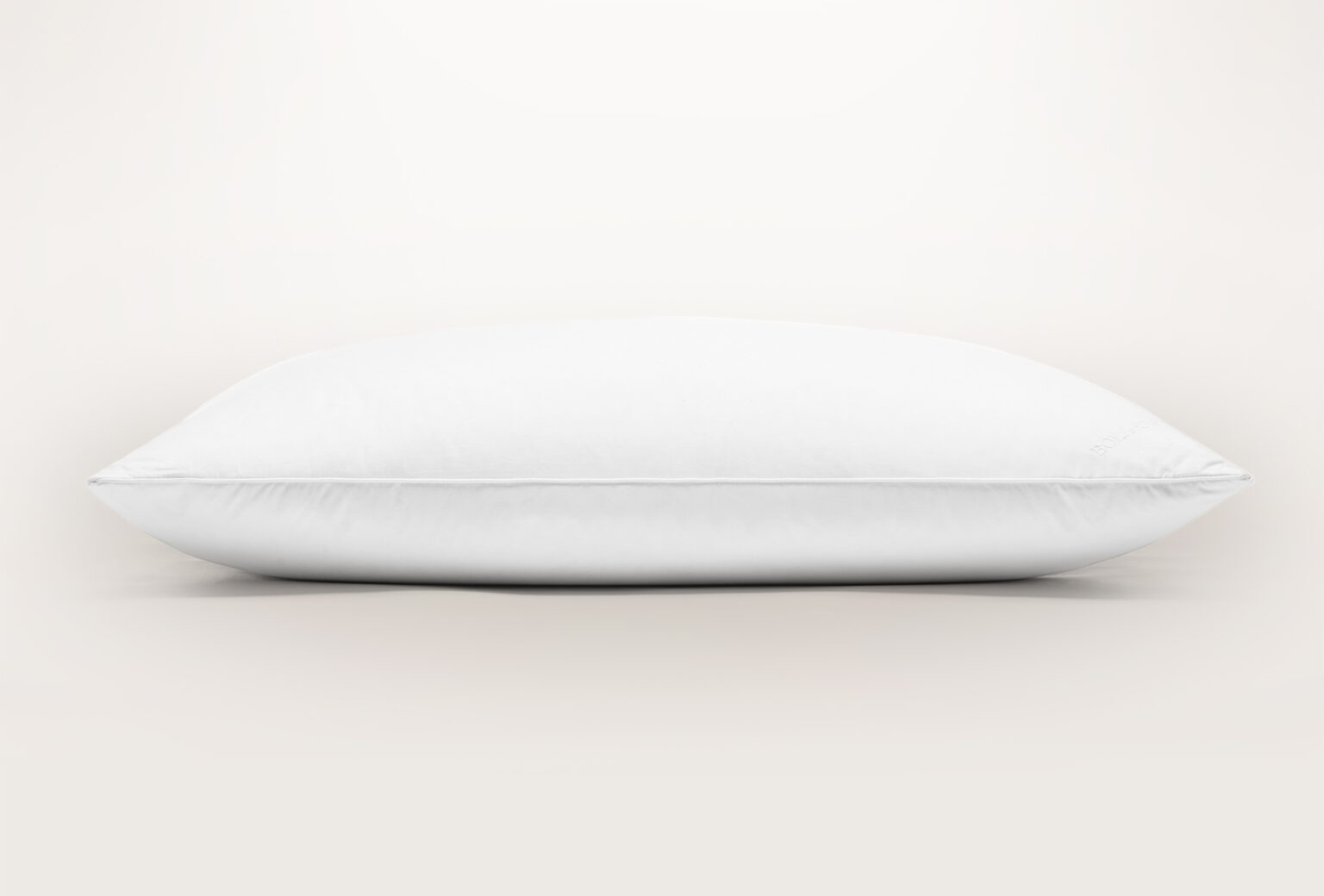
Best for Combination Sleepers
Boll & Branch Down Alternative Pillow

Price:
$88 – $98Fill:
PrimaLoft synthetic microfibersFirmness:
Soft, Medium, Firm-
Who it’s best for:
- People who frequently change positions at night
- Shoppers who like the feel of down but prefer not to use animal-derived products
- Those with persistent neck pain
-
Highlights:
- PrimaLoft fibers contour to the neck to alleviate pressure
- Breathable organic cotton shell regulates temperature
- Three firmness options
Sleep Foundation Special Offer
Use this link for the most current discount.
Bottom Line
Three firmness options make the Boll & Branch Down Alternative Pillow great for many sleeper types, but our testing indicated it especially suited combination sleepers. The medium firm model has an exceptionally balanced feel that should suit sleepers who switch positions throughout the night.
Combination sleepers often benefit from a pillow with a balanced feel to support their bodies in any position they choose. The Boll & Branch Down Alternative Pillow offers significant contouring for the neck to alleviate pressure, and you can choose between three firmness levels. Our testing found the medium feel most versatile, making it an excellent option for combination sleepers.
How It Performed
Soft, medium, and firm options are available, each appealing to different sleeper types. Our stomach sleepers appreciated the softest model, which kept the neck at a comfortable angle and prevented strain. The medium feel suits most sleeper types, but it earned its highest ratings from our back-sleeping testers. Side sleepers on our team appreciated the firmest model, as it cushioned the head and shoulders and prevented pressure points from forming.
Our testing found the pillow’s main strength was how it contoured to the head and neck. Sleepers who experience uncomfortable pressure buildup should find the pillow reduces aches and pains.
What It’s Made Of
The pillow is filled with PrimaLoft down alternative fibers. The fibers give the pillow a plush and lofty feel similar to down without heat retention or potential allergens. Organic cotton makes up the pillow shell, which has a soft and breathable feel. The pillow is machine-washable, provided your machines are large enough to accommodate it. Boll & Branch recommends washing the pillow in cold water on a gentle cycle and tumble drying on low heat. Fully drying the pillow may take several drying cycles.
Standard and king size pillows are available. Boll & Branch ships free to customers in the contiguous U.S. You can return the Down Alternative Pillow within 30 days of delivery for a full refund.
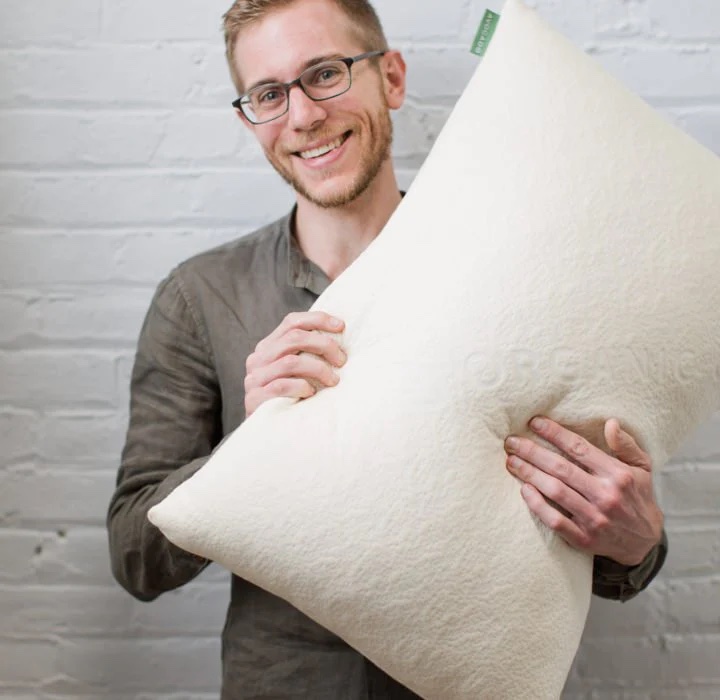
Best Organic
Avocado Green Pillow
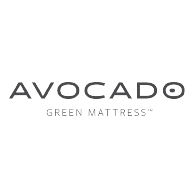
Price:
$89 – $109Fill:
GOLS-certified shredded latex and GOTS-certified kapok fibersFirmness:
Medium-
Who it’s best for:
- Eco-conscious shoppers
- Side and back sleepers
- Hot sleepers
-
Highlights:
- Materials hold GOLS and GOTS certifications
- Naturally breathable latex and cotton help regulate temperature
- Adjustable loft
Sleep Foundation Special Offer
Use this SleepFoundation.org link for the most current discount on Avocado pillows
Bottom Line
The Avocado Green Pillow holds multiple sustainable certifications, which should appeal to eco-conscious shoppers. Natural materials like latex, kapok, and cotton are also breathable, making this pillow a good fit for hot sleepers.
Sleepers willing to spend a bit more on a hypoallergenic pillow made with certified organic materials will appreciate the Avocado Green Pillow. The pillow boasts Global Organic Textile Standard (GOTS) and Global Organic Latex Standard (GOLS) certifications, ensuring the materials were responsibly sourced and produced.
How It Performed
The Green Pillow’s adjustable loft and medium firmness level felt comfortable for many of our testers. Our side and back sleepers appreciated the generous cushioning for the neck, and the adjustable loft allowed them to pick a height that best supported the neck and shoulders. Some stomach sleepers may also enjoy the pillow, but those over 230 pounds may find that the latex’s density causes the neck to crane into an uncomfortable position.
Temperature regulation was one of the pillow’s major strengths. Hot sleepers on our team found the shredded fill materials encouraged internal airflow, while the breathable cover kept the surface cool to the touch. Our heat guns also detected minimal heat retention on the surface.
Those with aches and pains in their necks should also appreciate the pillow’s contouring, which helps alleviate pressure buildup. We found the latex had a slight odor after unboxing, but it shouldn’t trigger allergies. If you are especially sensitive to smells, leaving the pillow in a well-ventilated room for a few hours should help odors dissipate quickly.
What It’s Made Of
The Green Pillow features a blend of 70% shredded latex and 30% kapok fibers. Together, these materials offer a plush surface for the head and neck without sacrificing responsive support. The fill materials are encased in an organic jersey cotton inner liner. The pillow’s outer cover is made from quilted organic cotton, and it is machine-washable for easy care. Wash the cover in cold water and hang to dry. Avocado recommends spot-cleaning the pillow insert.
Shipping is free to customers in all 50 states. Avocado offers a 100-night sleep trial, during which you can test the pillow and return it for a full refund. If you decide to keep the Green Pillow, the brand backs it with a one-year manufacturer’s warranty.
Why You Should Trust Us
Here at Sleep Foundation, we have decades of sleep product testing under our belt. We tested countless pillows made with hypoallergenic materials to determine our top picks. For our first-hand pillow tests, we place each pillow on the same mattress to make sure our ratings are consistent.
Our testers lie on each pillow and physically handle them to test their moldability, shape retention, support, and conforming performance. Then, we use devices like heat guns and VOC meters to measure heat retention and off-gassing. Our team includes people across sleeping positions, body types, and sleep preferences, ensuring our recommendations are balanced.
What Are Hypoallergenic Pillows?
Hypoallergenic pillows are designed to prevent the buildup of allergens like dander, mold, and dust mites, which can trigger reactions like sneezing, a runny nose, or skin irritation in people with sensitivities.
Down alternative, memory foam, latex, and microfiber are often used inside hypoallergenic pillows because they are less likely to trigger adverse reactions. Cover materials can include cotton, silk, bamboo-derived viscose, or Tencel. Some hypoallergenic pillows may also be treated with special coatings to make them more resistant to potential allergens.
Benefits of Using Hypoallergenic Pillows
Hypoallergenic pillows may reduce exposure to allergens and, as a result, may reduce the occurrence and intensity of allergic reactions. Because allergies can interfere with nightly comfort and rest, a hypoallergenic pillow may facilitate more restorative sleep.
These pillows are typically made of high-quality materials that can increase their longevity. As a result, even though they may be more expensive upfront, hypoallergenic pillows can be a cost-effective option for shoppers who want a good return on their investment. In addition, some hypoallergenic pillows are designed to withstand regular washing in hot water, which can help kill germs and eliminate allergens.
Types of Hypoallergenic Pillows
Hypoallergenic pillows are classified by the type of fill, which is the interior material. Popular types of fill include latex, memory foam, down alternative, wool, polyester, and microfiber.
Latex
Natural latex is derived from the sap of rubber trees. It has become a popular bedding material due to its durability, breathability, bounciness, and resistance to microbes. It’s important to note that people who are allergic to latex should avoid using a latex pillow, even if it’s marketed as hypoallergenic.
Latex pillows typically offer a springy feel with excellent temperature regulation and moderate contouring to the head and neck. Products made with natural or organic latex tend to lack the off-gassing odors that are common with other types of foam, which can be a significant selling point for people with sensitivities to chemical smells.
Memory Foam
Memory foam pillows consist of shredded or solid foam that provides exceptional contouring to cushion the head and neck. While memory foam can resist certain allergens, it can attract dust, so it’s helpful to take care to prevent buildup of dust mites and dirt.
Foam pillows often emit odors when first unpackaged. Although the smell usually fades within a few days, people who are sensitive to smells may be bothered by this aspect of memory foam pillows.
Memory foam’s contouring nature tends to lead to more heat retention, so many companies infuse the foam with gel designed to create a cooling pillow for hot sleepers. Because memory foam generally isn’t machine-washable, a pillow protector is recommended to keep it clean and maintain its quality.
Down Alternative
As its name suggests, down alternative is designed to mimic the light, fluffy texture of down feathers by using synthetic fibers. Common down alternative materials include polyester and microfiber.
Down alternative is a popular choice for people who are allergic to down and those who prefer an easy-to maintain pillow. Down alternative pillows are usually machine-washable and offer an affordable, comfortable alternative to more expensive options like latex and natural down.
Down alternative is unlikely to trigger allergic reactions, but its loose fill may harbor dust mites. Regular washing and using a pillow protector can help prevent dust mites from accumulating.
Wool
Wool is a durable fiber sourced from sheep that is naturally resistant to dust mites and bacteria. It’s an effective insulator for all seasons thanks to its moisture-wicking capabilities that also limit the development of mold and mildew. Wool’s ability to absorb moisture without feeling damp may benefit people who perspire at night.
Polyester
Polyester pillows appeal to many people because they are usually plush, affordable, and versatile. The synthetic fibers resist allergens and can create a light and fluffy feel, although they tend to compress over time and become less supportive. Polyester’s loose texture can attract dust mites, so regular washing is recommended.
You may need to replace a polyester pillow more frequently than other types of pillows because polyester isn’t as durable as materials like latex, foam, and wool. On a positive note, polyester generally stays cooler than memory foam and rarely has any off-gassing odors. Additionally, some polyester pillows can be customized by adding or removing fill.
Microfiber
Microfiber is a lightweight, synthetic material made of extremely thin fibers. It’s a relative newcomer as a bedding fabric but has gained popularity for its soft feel, affordability, and ease of care. Microfiber is most often made using polyester as its base material, though nylon is also used in some varieties. Although lightweight, it lacks the breathability of natural materials.
In a hypoallergenic pillow, microfiber offers a plush surface that dries quickly. Microfiber pillows usually stand up well to regular laundering in a washing machine, so keeping them clean requires minimal time and effort.
How to Choose the Best Hypoallergenic Pillow for You
When choosing a pillow, some important factors to consider include loft, firmness, temperature regulation, quality of materials, and ease of care. We’ll discuss each of these in more detail to help you make an informed decision.
Firmness
A pillow’s firmness affects how your head will sink into it and is linked with the overall support a pillow provides. Optimal firmness is largely subjective, though side sleepers tend to enjoy firmer pillows, with stomach sleepers typically opting for softer models and back sleepers often preferring a mid-range firmness level.
Hypoallergenic pillows can be found in all levels of firmness. Firm pillows may be less likely to trap allergens and bacteria because they don’t fold and crease as much as plusher versions. However, with regular cleaning and maintenance, any hypoallergenic pillow can be kept clean to help eliminate allergens.
Fill Material
The type of fill material directly impacts a pillow’s feel, performance, and price. For example, some materials provide better temperature regulation, more cushioning, or a lower price tag.
Even though they can be hypoallergenic in general, certain fill materials like latex may still trigger allergic reactions in some people. For this reason, it’s important to look closely at the fill material and the fabric in the pillow cover to find a pillow that is safe for you.
Cover Material
In addition to the fill, you should look closely at how the cover or shell of the pillow is constructed. The cover may be tightly woven to keep dust and allergens out, or it may have a more open weave to permit airflow. Some cover materials are more breathable or add softness, which may factor into the overall performance of the pillow. In some cases, you may want to use an encasement or pillow protector that goes over the entire pillow.
Size
Choosing a properly sized pillow is important for optimal comfort and support, and it can also impact a hypoallergenic pillow’s effectiveness. An overly large pillow has more surface area that can accumulate dust, and it may be more work to clean. You should also consider the size of your bed and make sure your pillows are a good fit.
Loft
Loft is another word for a pillow’s thickness or height. Your primary sleep position will largely determine the appropriate loft. Side sleepers usually need a high-loft pillow. Back sleepers typically prefer a medium loft, while stomach sleepers generally require a low-loft option.
A pillow’s firmness level also relates to the loft. For instance, a high-loft pillow that is soft will compress when being used, reducing its height and affecting the amount of neck support it provides.
Ease of Care
Hypoallergenic pillows require regular cleaning, so it’s advisable to purchase one that fits seamlessly into your lifestyle. If you skip washing your pillow because of inconvenience, it will accumulate dirt and allergens. Many hypoallergenic pillows are machine-washable, but some materials require spot-cleaning to avoid damaging the pillow.
Quality Materials
A hypoallergenic pillow made with high-end materials may help prevent allergens from building up inside the pillow. Most shells or covers are constructed with a tight weave that acts as a barrier against dust mites and other contaminants. Quality materials also tend to be more comfortable and durable.
Temperature Regulation
A pillow that effectively regulates temperature can minimize perspiration and help you stay cool and comfortable. Materials like memory foam are more prone to retaining heat than latex or wool.
Besides offering temperature regulation, some cooling materials have an ability to wick away moisture, which may prevent the growth of mold or mildew that can irritate breathing conditions or trigger allergies.
Price
Hypoallergenic pillows have varying price-points depending on their materials and construction. To shop effectively, be sure to consider your budget and decide what price range is most suitable. This will narrow your options and help you find the best pillow for you. In general, we recommend buying the highest-quality pillow you can afford to get the most return on your investment.
Sleeping Position
Your primary sleep position influences how much support you need and what type of pillow is most comfortable. Side sleepers typically require the most support because of the increased distance between their head and the sleep surface. With this in mind, side sleepers may prefer a hypoallergenic pillow with more loft that is made with latex or memory foam.
Back sleepers and particularly stomach sleepers want to avoid excess pillow height that can strain the neck, so they may benefit from a lower-loft model with a softer material like down alternative, polyester, or microfiber.
Pressure Relief
Besides minimizing allergens, a hypoallergenic pillow should also provide adequate pressure relief by cushioning sensitive areas of the head and neck. Pain and discomfort can disrupt sleep, and poor sleep may impair the immune system that guards against illness. When shopping, look for a hypoallergenic pillow that can both protect against allergens and support your body, allowing you to get healthy rest.
How to Buy a Hypoallergenic Pillow Online
Shopping online enables you to consider a large range of options for hypoallergenic pillows. Carefully reading product descriptions, reviews, and return policies can help ensure success in finding the right pillow
Read Product Descriptions
A pillow’s product description includes important information about its materials, dimensions, construction, and features. It will specify the fill material and the fabric in the cover. Special features such as adjustable loft, cooling technologies, or a hypoallergenic treatment should also be listed.
Check Reviews
Reviews are a great way to find out how the pillow has worked for other people. They often reveal details pertaining to daily use that you won’t find in the product description. You may find reviews from people in similar circumstances or detect a common theme relating to a particular element of the pillow’s performance.
Consider the Return Policy
It’s advisable to check any pillow’s return policy to avoid ending up with an uncomfortable pillow or one that doesn’t help reduce your allergy symptoms. Many manufacturers offer sleep trials ranging from 30 to 365 days to ensure customer satisfaction.
If you’re not sure about what type of pillow will work for you, a longer sleep trial can give you plenty of time to make sure it is suitable. When looking at the return policy, read carefully to see if there are any restocking or shipping fees that would be deducted from your refund if you decide to return the pillow.
Look for Certifications
To find a pillow that has been proven to reduce allergens, look for certifications from organizations like Allergy Standards Ltd. or the Asthma and Allergy Foundation of America. Pillows with these certifications have been tested and shown to be hypoallergenic. However, keep in mind that a pillow can still be hypoallergenic even if it hasn’t been evaluated by a certifying organization.
Compare Prices
A good way to get the most value for your money is to compare the prices of similar products from different manufacturers. Sticking to your chosen price range will filter out pillows that don’t fit into your budget and can keep you from getting overwhelmed. Timing your shopping, such as around Black Friday or another promotional event, can help you save money and get better value.
How to Care For Hypoallergenic Pillows
Hypoallergenic pillows require regular care to maintain their performance and quality. This may involve fluffing, spot-cleaning, or machine-washing. Care instructions vary according to materials, so we recommend reading and following the directions on the manufacturer’s label.
A pillow protector is another way to keep your pillow safe from damage, especially in the case of a memory foam pillow that can’t be washed in a machine. Pillow protectors preserve the integrity of the fibers by adding another layer of protection against dust mites, dirt, and mold.
Keep an eye out for any signs of grime or dirt buildup on your pillow, which can be an indication that it is in need of cleaning. In addition, keeping the pillow in a well-ventilated space can help reduce the accumulation of allergens.
Frequently Asked Questions
Searching for a specialty item like a hypoallergenic pillow can be challenging. To help you shop successfully, we’ll answer some of the most common questions posed by people looking for a new pillow.
Do Hypoallergenic Pillows Really Reduce Allergies?
Hypoallergenic pillows can minimize allergic reactions for some people, though they don’t eradicate allergies themselves. These pillows are designed to reduce the buildup of allergens by using specific materials in the fill or cover.
That said, the effectiveness of hypoallergenic pillows depends on factors like regular care, the cleanliness of your bedroom, and your specific sensitivities. With multiple materials to choose from, you may find that one type of hypoallergenic pillow works better for you than another.
Can You Wash Hypoallergenic Pillows in a Washing Machine?
Many hypoallergenic pillows are machine-washable, but some require more delicate handling. Therefore, it’s critical to check the manufacturer’s care instructions before cleaning. For example, polyester pillows can typically be machine-washed, while solid memory foam and latex pillows generally cannot and must be spot-cleaned.
How Often Should I Replace a Hypoallergenic Pillow?
Most pillows need to be replaced every one to two years, but those made with high-quality materials may last longer. Hypoallergenic pillows made of polyester typically have the shortest lifespans, while latex models tend to be extremely durable. When your pillow no longer provides adequate comfort and support or becomes permanently stained or odorous, it’s time to get a new one.
Are Hypoallergenic Pillows Expensive?
Hypoallergenic pillows vary in price depending on their materials and how well they are made. Some options are budget-friendly at less than $20 for a two-pack. Others are significantly more expensive. Many high-quality pillows average around $100 and can cost as much as $300. Specialty items, like organic pillows, tend to have higher price tags.

Still have questions?
Our product experts have extensive experience testing just about every sleep product on the market. Send an email to AskAnExpert@sleepfoundation.org or call us at (877) 672-8966 with your questions and we’ll help you find exactly what you’re looking for.

